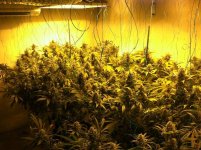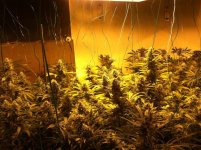ChronicChris
New member
Hey everyone!
Lots of people say chemicals produce the biggest yields. I don't think this is true.
Here is my latest run using Veganics. I did two plants per 1000 watt light and bent them using a modified super cropping method. I used West Coast Horticulture Grow 213, Bloom 224, Micronutrients and Chelated Calcium. I used wire tie stapled to the ceiling to tie up all the heavy buds so they would fill out fully. I have found not tying the buds up lowers yields substantially. Yield was very high quality Sour Diesel and just over two Lbs per 1000 watt lights! Does anyone else have experience using West Coast Horticulture nutrients?
I have grown with chemicals and organic nutrients over the years and as far as I can tell organics produce just as good of yields as chemicals.
Lots of people say chemicals produce the biggest yields. I don't think this is true.
Here is my latest run using Veganics. I did two plants per 1000 watt light and bent them using a modified super cropping method. I used West Coast Horticulture Grow 213, Bloom 224, Micronutrients and Chelated Calcium. I used wire tie stapled to the ceiling to tie up all the heavy buds so they would fill out fully. I have found not tying the buds up lowers yields substantially. Yield was very high quality Sour Diesel and just over two Lbs per 1000 watt lights! Does anyone else have experience using West Coast Horticulture nutrients?
I have grown with chemicals and organic nutrients over the years and as far as I can tell organics produce just as good of yields as chemicals.






